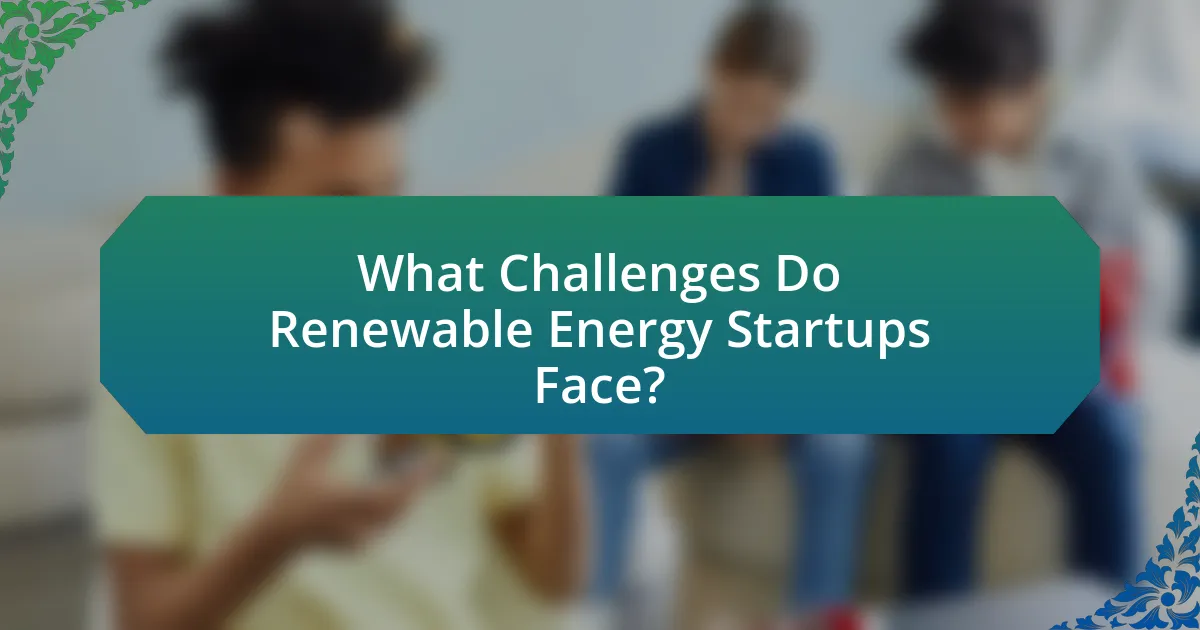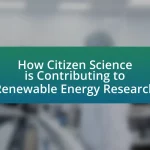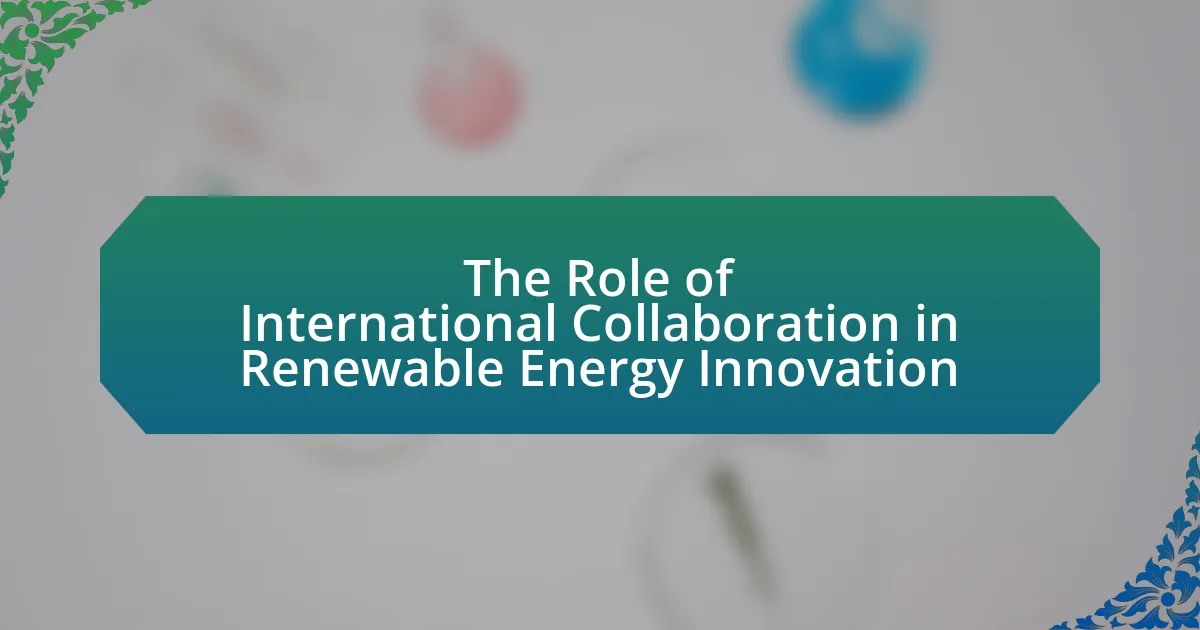The article focuses on case studies of successful renewable energy startups, highlighting notable companies such as Tesla and NextEra Energy. It examines the factors contributing to their success, including innovative technology, strong market demand, effective business models, and access to funding. The article also discusses the impact of market conditions and regulatory environments on these startups, as well as the challenges they face, such as high capital requirements and competition. Key lessons learned from these case studies emphasize the importance of adaptability, strategic partnerships, and understanding consumer preferences in driving growth within the renewable energy sector.

What are Case Studies of Successful Renewable Energy Startups?
Successful renewable energy startups include companies like Tesla, which revolutionized the electric vehicle market and energy storage solutions with its Powerwall, and NextEra Energy, a leader in wind and solar energy production. Tesla’s market capitalization reached over $800 billion in 2021, showcasing its impact on the renewable sector. NextEra Energy, recognized as the world’s largest producer of wind and solar energy, reported revenues exceeding $19 billion in 2020, demonstrating the financial viability of renewable energy investments. These case studies illustrate how innovation and strategic focus on sustainability can lead to significant market success in the renewable energy industry.
How do these case studies illustrate the growth of renewable energy startups?
These case studies illustrate the growth of renewable energy startups by showcasing their innovative solutions and market adaptability. For instance, companies like Tesla and NextEra Energy have demonstrated significant revenue increases, with Tesla reporting over $31.5 billion in revenue in 2020, largely driven by its solar and energy storage products. Additionally, the rise in venture capital investment in renewable energy, which reached $16.1 billion in 2020, highlights the increasing confidence in these startups’ potential to disrupt traditional energy markets. These examples reflect a broader trend of growing consumer demand for sustainable energy solutions, further validating the expansion of the renewable energy sector.
What key factors contribute to the success of these startups?
The key factors contributing to the success of renewable energy startups include innovative technology, strong market demand, effective business models, and access to funding. Innovative technology allows these startups to offer unique solutions that meet the growing need for sustainable energy sources. Strong market demand is driven by increasing awareness of climate change and government incentives for renewable energy adoption. Effective business models enable startups to scale operations and reach profitability, while access to funding from venture capital and government grants provides the necessary resources for growth and development. For instance, according to a report by the International Renewable Energy Agency, investment in renewable energy reached $282 billion globally in 2019, highlighting the financial support available for successful startups in this sector.
How do market conditions influence the outcomes of these case studies?
Market conditions significantly influence the outcomes of case studies on successful renewable energy startups by determining the demand for renewable technologies, access to funding, and regulatory support. For instance, favorable market conditions, such as government incentives and increasing consumer demand for clean energy, can lead to higher adoption rates of renewable solutions, as seen in the rapid growth of solar energy companies during periods of supportive policies. Conversely, adverse market conditions, like economic downturns or reduced subsidies, can hinder growth and lead to failures, as evidenced by startups that struggled during periods of low fossil fuel prices. These dynamics illustrate how market conditions directly impact the viability and success of renewable energy ventures.
What lessons can be learned from these successful startups?
Successful renewable energy startups demonstrate the importance of innovation, adaptability, and market understanding. These companies often thrive by leveraging cutting-edge technology to create sustainable solutions, as seen in the rise of solar and wind energy firms that have significantly reduced costs through advancements in efficiency. For instance, the solar startup SunPower achieved a 50% reduction in costs over a decade, showcasing the impact of continuous innovation. Additionally, successful startups emphasize the need for strong partnerships and collaboration, which can enhance resource sharing and market reach, as evidenced by companies like Tesla, which collaborates with various stakeholders to expand its electric vehicle and energy storage solutions. Lastly, understanding regulatory environments and consumer preferences is crucial; startups that align their offerings with market demands, such as energy efficiency and sustainability, tend to perform better, as demonstrated by the rapid growth of companies like NextEra Energy, which focuses on renewable energy sources in response to increasing consumer demand for clean energy.
What strategies did these startups employ to overcome challenges?
Successful renewable energy startups employed several strategies to overcome challenges, including innovative technology development, strategic partnerships, and adaptive business models. For instance, startups like Tesla and Sunrun focused on advancing battery technology and solar panel efficiency, which allowed them to reduce costs and improve performance. Additionally, forming partnerships with established companies and government entities enabled these startups to access funding, resources, and market opportunities. Furthermore, many of these startups adopted flexible business models that allowed them to pivot in response to market demands and regulatory changes, ensuring their sustainability and growth in a competitive landscape.
How did innovation play a role in their success?
Innovation was crucial to the success of renewable energy startups by enabling the development of advanced technologies that improved efficiency and reduced costs. For instance, companies like Tesla and SunPower introduced innovative solar panel designs and energy storage solutions that significantly enhanced energy capture and storage capabilities. These innovations not only differentiated them in a competitive market but also attracted substantial investment, leading to rapid growth and market penetration. Furthermore, the integration of smart grid technology and data analytics allowed these startups to optimize energy distribution and consumption, further solidifying their market position and driving their overall success.

Which Renewable Energy Startups are Notable Examples?
Notable examples of renewable energy startups include Tesla, which focuses on solar energy and battery storage solutions, and NextEra Energy, known for its significant investments in wind and solar power. Additionally, companies like Ørsted have transitioned from fossil fuels to become leaders in offshore wind energy. These startups have demonstrated substantial growth and innovation in the renewable energy sector, contributing to a more sustainable energy landscape. For instance, Tesla’s solar products and energy storage systems have made significant impacts on residential energy consumption, while NextEra Energy is recognized as one of the largest producers of wind and solar energy in the world.
What are the standout features of each case study?
The standout features of each case study in “Case Studies of Successful Renewable Energy Startups” include innovative technology adoption, strategic partnerships, and scalable business models. For instance, one case study highlights a startup that developed a breakthrough solar panel technology, significantly increasing energy efficiency by 30%, which demonstrates the impact of innovation. Another case study showcases a company that formed strategic alliances with local governments, facilitating access to funding and resources, thereby enhancing its market reach. Additionally, a third case study illustrates a startup with a scalable business model that allows for rapid expansion into new markets, evidenced by its growth rate of 150% year-over-year. These features collectively underscore the critical elements contributing to the success of renewable energy startups.
How did each startup differentiate itself in the market?
Each startup in the renewable energy sector differentiated itself through unique value propositions tailored to specific market needs. For instance, one startup focused on innovative solar panel technology that increased efficiency by 20%, setting it apart from competitors. Another startup specialized in energy storage solutions, offering a battery system with a longer lifespan and faster charging capabilities, which appealed to consumers seeking reliability. Additionally, a third startup emphasized sustainability by utilizing recycled materials in its products, attracting environmentally conscious customers. These strategic differentiations not only enhanced their market presence but also addressed specific consumer demands, leading to increased adoption and customer loyalty.
What specific technologies did these startups leverage?
Successful renewable energy startups leveraged technologies such as solar photovoltaic systems, wind turbines, energy storage solutions, and smart grid technology. For instance, solar photovoltaic systems convert sunlight into electricity, while wind turbines harness wind energy for power generation. Energy storage solutions, like lithium-ion batteries, enable the storage of energy for later use, enhancing reliability. Smart grid technology optimizes energy distribution and consumption, improving efficiency. These technologies are foundational in driving innovation and sustainability within the renewable energy sector.
What impact did these startups have on the renewable energy sector?
These startups significantly advanced the renewable energy sector by introducing innovative technologies and business models that increased efficiency and reduced costs. For instance, companies like Tesla have revolutionized energy storage with their battery technology, enabling more effective integration of solar and wind energy into the grid. Additionally, startups such as Sunrun have expanded access to solar energy through residential leasing models, leading to a substantial increase in solar installations across the United States. According to the Solar Energy Industries Association, the U.S. solar market grew by 167% from 2010 to 2020, largely driven by these innovative startups.
How did they influence industry trends and consumer behavior?
Successful renewable energy startups influenced industry trends and consumer behavior by driving innovation and increasing the adoption of sustainable practices. These companies introduced advanced technologies, such as solar panels and energy storage solutions, which made renewable energy more accessible and cost-effective. For instance, Tesla’s development of solar roof tiles and Powerwall batteries not only showcased the potential of integrating renewable energy into everyday life but also encouraged consumers to consider solar energy as a viable alternative to traditional power sources. Additionally, startups like NextEra Energy and Ørsted have shifted market dynamics by prioritizing clean energy investments, prompting larger corporations to follow suit and adopt more sustainable practices. This shift has been reflected in consumer preferences, with a growing number of individuals actively seeking eco-friendly products and services, as evidenced by a 2021 Nielsen report indicating that 73% of global consumers are willing to change their consumption habits to reduce environmental impact.
What role did partnerships and collaborations play in their success?
Partnerships and collaborations were crucial in the success of renewable energy startups by providing access to resources, expertise, and market opportunities. For instance, many startups partnered with established energy companies to leverage their distribution networks and technical know-how, which accelerated product development and market entry. Additionally, collaborations with research institutions facilitated innovation through shared knowledge and technology advancements, exemplified by the partnership between a solar startup and a university that led to the development of more efficient solar panels. These strategic alliances not only enhanced credibility but also attracted investment, as investors often view partnerships as a sign of stability and potential for growth.

What Challenges Do Renewable Energy Startups Face?
Renewable energy startups face significant challenges, including high initial capital requirements, regulatory hurdles, and market competition. High capital costs are often necessary for research, development, and deployment of technology, which can deter investment. Regulatory hurdles arise from complex policies and varying standards across regions, making compliance difficult and time-consuming. Additionally, competition from established energy companies and other startups can limit market access and customer acquisition. According to a report by the International Renewable Energy Agency, 70% of renewable energy startups cite funding as a primary barrier to growth, highlighting the financial challenges they encounter.
How do regulatory environments affect startup success?
Regulatory environments significantly influence startup success by shaping the operational landscape, funding opportunities, and market access. Startups in the renewable energy sector, for instance, often rely on government incentives, subsidies, and clear regulatory frameworks to thrive. According to a study by the International Renewable Energy Agency, countries with supportive regulatory policies saw a 50% increase in renewable energy investments compared to those with less favorable regulations. This demonstrates that a conducive regulatory environment can enhance investor confidence and facilitate growth, ultimately leading to higher rates of startup success in the renewable energy industry.
What common regulatory hurdles do these startups encounter?
Renewable energy startups commonly encounter regulatory hurdles such as complex permitting processes, inconsistent state and federal policies, and compliance with environmental regulations. These challenges can delay project timelines and increase operational costs. For instance, the National Renewable Energy Laboratory reported that lengthy permitting can add up to 30% to project costs, highlighting the financial impact of regulatory inefficiencies. Additionally, varying regulations across states can create confusion and hinder market entry for startups, as evidenced by the differing renewable portfolio standards in the U.S. This inconsistency complicates strategic planning and resource allocation for these companies.
How can startups navigate these regulatory challenges effectively?
Startups can navigate regulatory challenges effectively by establishing a strong compliance framework and engaging with regulatory bodies early in their development. This proactive approach allows startups to understand the specific regulations that apply to their industry, such as environmental standards and safety requirements, which are critical in the renewable energy sector. For instance, companies like Tesla have successfully engaged with regulators to shape policies that support innovation while ensuring compliance. By participating in industry associations and advocacy groups, startups can also gain insights and share best practices, further enhancing their ability to adapt to regulatory changes.
What financial challenges do renewable energy startups typically face?
Renewable energy startups typically face significant financial challenges, including high initial capital requirements and difficulty in securing funding. The capital-intensive nature of renewable energy projects often necessitates substantial upfront investment for technology development, infrastructure, and regulatory compliance. According to a report by the International Renewable Energy Agency, the average cost of solar photovoltaic systems can exceed $1,000 per installed kilowatt, which underscores the financial burden on startups. Additionally, these startups frequently encounter challenges in attracting investors due to perceived risks and uncertainties in the market, as highlighted by a study from the World Economic Forum, which indicates that many investors remain cautious about the long payback periods associated with renewable energy investments.
How do funding sources impact the growth of these startups?
Funding sources significantly impact the growth of renewable energy startups by providing the necessary capital for development, scaling, and innovation. Access to diverse funding options, such as venture capital, government grants, and crowdfunding, enables startups to invest in research and development, hire skilled personnel, and expand their market reach. For instance, a study by the International Renewable Energy Agency (IRENA) found that startups with venture capital backing grow 20% faster than those relying solely on personal savings or loans. This accelerated growth is often attributed to the strategic guidance and networking opportunities that come with institutional investment, which can lead to partnerships and increased visibility in the market.
What strategies can startups use to secure investment?
Startups can secure investment by developing a compelling business plan that clearly outlines their value proposition, market opportunity, and financial projections. A well-structured business plan attracts investors by demonstrating the startup’s potential for growth and profitability. According to a study by the Kauffman Foundation, startups with detailed business plans are 16% more likely to secure funding compared to those without. Additionally, building a strong network through industry connections and attending relevant events can enhance visibility and credibility, further increasing the chances of attracting investors.
What are the best practices for aspiring renewable energy startups?
Aspiring renewable energy startups should focus on developing a clear business model that addresses market needs and regulatory requirements. This involves conducting thorough market research to identify gaps and opportunities within the renewable energy sector. For instance, successful startups like Tesla and NextEra Energy have demonstrated the importance of innovation in product offerings and technology integration, which can lead to competitive advantages.
Additionally, building strategic partnerships with established companies and stakeholders can enhance credibility and access to resources. According to a report by the International Renewable Energy Agency (IRENA), collaboration is crucial for scaling operations and achieving sustainability goals.
Furthermore, securing adequate funding through grants, venture capital, or government incentives is essential for operational viability. The U.S. Department of Energy has highlighted that financial backing significantly influences the growth trajectory of renewable energy ventures.
Lastly, focusing on sustainability and social responsibility can improve brand reputation and customer loyalty, as consumers increasingly prefer environmentally conscious companies. Research from Nielsen indicates that 66% of global consumers are willing to pay more for sustainable brands, underscoring the importance of aligning business practices with environmental values.
How can startups effectively build a sustainable business model?
Startups can effectively build a sustainable business model by focusing on creating value through innovative solutions that address environmental challenges. This involves identifying a specific market need within the renewable energy sector, such as solar, wind, or energy efficiency, and developing products or services that meet that need while minimizing ecological impact. For instance, companies like Tesla have successfully integrated sustainable practices by producing electric vehicles and energy storage solutions, demonstrating that aligning business goals with sustainability can lead to profitability. Additionally, leveraging partnerships with established organizations and utilizing government incentives can enhance financial viability and market reach, as evidenced by numerous startups that have thrived through collaborations and funding opportunities in the renewable energy landscape.
What key metrics should startups track for success?
Startups should track key metrics such as customer acquisition cost (CAC), lifetime value (LTV), monthly recurring revenue (MRR), and churn rate for success. Customer acquisition cost measures the total cost of acquiring a new customer, which helps in assessing marketing efficiency. Lifetime value indicates the total revenue expected from a customer over their relationship with the startup, providing insight into long-term profitability. Monthly recurring revenue reflects the predictable income generated from subscriptions, crucial for financial forecasting. Churn rate quantifies the percentage of customers lost over a specific period, highlighting retention effectiveness. Tracking these metrics allows startups to make informed decisions, optimize operations, and drive growth.




